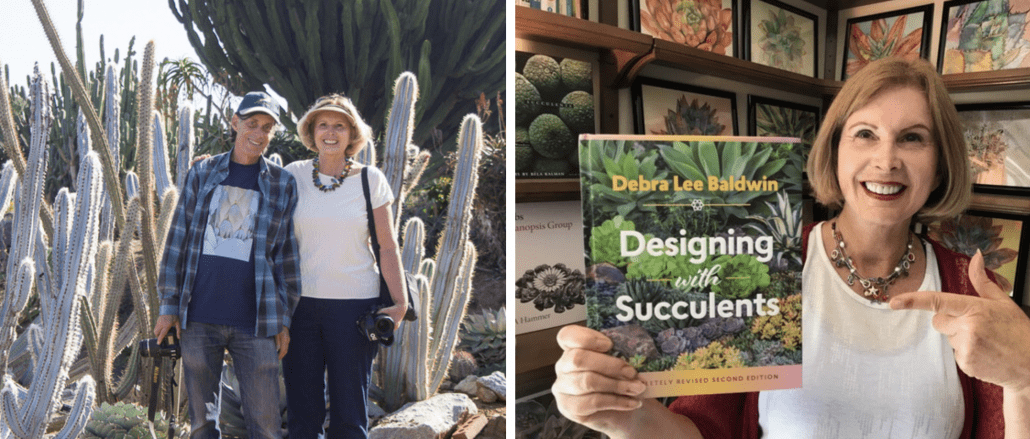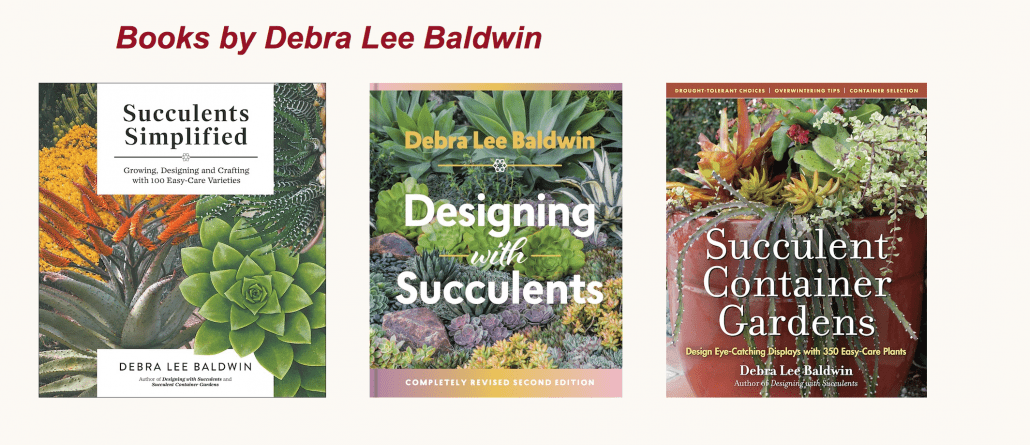
Behind the Scenes with “Designing With Succulents”
I’m about to give you a behind-the-scenes look at my book, Designing with Succulents (2nd ed.) by sharing Brian Kemble’s comments on its manuscript, prior to publication. He was of one of the proofreaders who went over my plant descriptions. This is a long post, so settle in and get comfortable.
Brian, a world-renowned horticulturist, shares my obsession with accuracy. However, I lack his decades of studying and growing thousands of cacti and succulents, and his memory for arcane and detailed plant information. Not that succulent cultivation and nomenclature are exact sciences, in fact, they’re rife with gray areas. Discussions can be lively—even heated—when geeks (I use the term respectfully) get together and discuss little-known succulents found only in, say, Zimbabwe or the Great Karoo.
Although Brian revels in that sort of stuff, he’s remarkably engaging when instructing the gardening public. He “gets” that not everyone is interested in obscure genera unsuitable for residential landscapes. At yearly Succulent Extravaganzas at Succulent Gardens nursery 200 miles south of San Francisco, Brian starts the festivities at 8 a.m. with a tour of the display gardens. Despite the nursery’s out-in-the-boonies location, he draws dozens of rapt listeners. Most are homeowners who are into gardening—as are the readers of my books.

You might wonder if Brian is eccentric, being so devoted to plants. Does he relate to people, too? Oh, my, yes. He’s active in the San Francisco Cactus & Succulent Society, travels the world with fellow enthusiasts to observe plants in habitat, lectures widely to C&SS groups, and interacts with visitors at the Ruth Bancroft Garden in Walnut Creek, CA, where he has served as curator for decades.
Yet there’s a certain reserve to Brian. He’s mild mannered, soft spoken, and polite. He’s not one to leap into the limelight, yet he’s good on camera. When speaking on his favorite topics—cacti and succulents, dry-climate gardening, and landscape design—he does so with a quiet intensity that’s perfectly delivered, interesting and engaging. Plus he has a delightfully dry sense of humor.
You’ll notice these things about his comments too, some of which made me laugh. Granted, much of what follows has to do with nomenclature and what one expert has to say versus another. Yet Brian sifts through all the lofty blather and draws conclusions that are reasonable, helpful, and—to an author whose reputation is at stake—a huge relief.
He’s also exquisitely diplomatic. Brian never states that what I wrote was wrong or stupid, although at times it was. I committed some “howlers”— editors’ slang for errors that, should they find their way into print, would cause erudite readers to howl with dismay (or, possibly, laughter).
Not only do Brian’s comments merit a wider audience, they illustrate the effort that went into the book. Credit also goes to the excellent staff at Timber Press, the largest publisher of gardening books in the US, who focused on style consistency, logical flow, readability, photo selection, design and layout, and copyediting.
If, as you read through Brian’s suggestions, you find one that’s a snooze, skim past it to a nugget or howler. It pleases me to imagine you discovering them as I did, and perhaps vicariously experiencing my mingled dismay, relief and gratitude.
I’ve included a few pages from the published book so you can see the final results. Enjoy! ~ Debra
Excerpts from horticulturist Brian Kemble’s proofreading comments on the manuscript of Designing with Succulents (2nd edition), by Debra Lee Baldwin
Page 37 — Furcraea macdougalii should be macdougallii (note that Fouquieria macdougalii has one L, but the furcraea has two).
Page 99 — I am glad to see you mentioned aeoniums in the caption. Lots of succulents do well in sea-side conditions, but some such as aeoniums and dudleyas seem MADE for this – you should mention dudleyas, too!
Page 101 — The cactus looks like Cleistocactus icosagonus (or Borzicactus icosagonus in Hunt’s newest taxonomy) rather than Disocactus martianus.

For plants to suggest underwater creatures, many gardens use dyckias (like the aptly-named Dyckia ‘Brittle Star’) for a sea star effect. You list medusoid euphorbias under the “sea urchin” category, but isn’t it sea anemones that you mean? Sea urchins have a spiky look, and your listings of E. horrida and polygona are indeed appropriate for this.
Page 114 — In the Thinking Outside the Pot section, I feel a little uneasy about “succulents are not dependent on their roots to survive.” Yes, they can go a long time living off their stored reserves, but sooner or later they need to send out some roots!
Page 122 — In the list of succulents for miniature landscapes, you didn’t mention two of my favorite Crassula species for this purpose: C. tetragona and C. ericoides (I see you do mention the former on the last page). The many dwarf othonnas and tylecodons are also good for this, suggesting larger pachycaul plants like pachypodiums. And a Mestoklema makes a great miniature banyan tree – but one could go on and on with this; the idea is really to just throw out some ideas, letting the reader take the ball and run with it.
Page 133 — In the photo, the plant on left is C. strausii, but the one on the right isn’t (spines too yellow).
Page 148 — To the list of succulents that can be propagated from leaves, you could add gasterias.
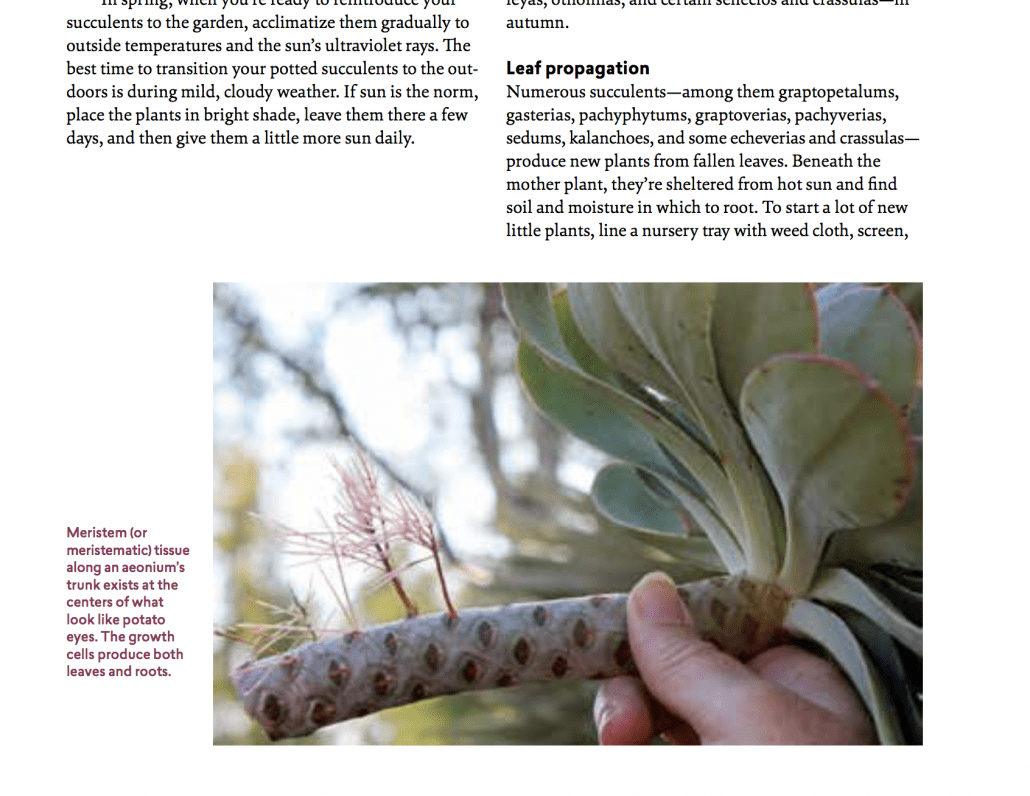
Page 176 — The correct name for the agave is A. parryi var. truncata, not A. parryi ‘Truncata’. One might quibble with whether var. truncata is really a good variety or not, but that is the way it is described in Gentry.
Page 177 — According to the Mexican botanists who published Agave pintilla, the name A. nickelsiae has priority over A. ferdinandi-regis because it was published earlier. However, A. ferdinandi-regis is such a well-known name that one can’t ignore it. I would handle this by calling the plant Agave nickelsiae (syn. Agave ferdinandi-regis).
Page 182 — Re aloes, the text says “Native to southern Africa, the Arabian Peninsula, and Madagascar…” This could be amended to “Native to southern and eastern Africa, the Arabian Peninsula, and Madagascar…” since there are so many widely grown aloes from East Africa, like juvenna, cameronii, camperi, elgonica, etc.
Page 184 — Aloe nobilis is a hybrid and not a species, so it should be rendered Aloe×nobilis to denote its hybrid origin. Since Aloe maculata has been the accepted name for A. saponaria for quite a few years, I would use it in the caption, with (syn. Aloe saponaria) following, or “also called Aloe saponaria,” as you have done with Aloe vera/barbadensis.
Page 188 — Having just called Aloe dorotheae “arguably the loveliest aloe”, it seems funny a couple of pages later to be crowning Aloe polyphylla as “arguably the most beautiful of all succulents.” Wouldn’t it be better not to repeat the word “arguably” and simply say something like, “Aloe polyphylla, spiral aloe, is one of the most striking of all succulents”?
Page 189 — For the Aloe speciosa photo caption, saying “flowers banded with cream, pink, and rose-red buds” leaves out the rust-orange of the stamens, which seems to me too prominent to ignore.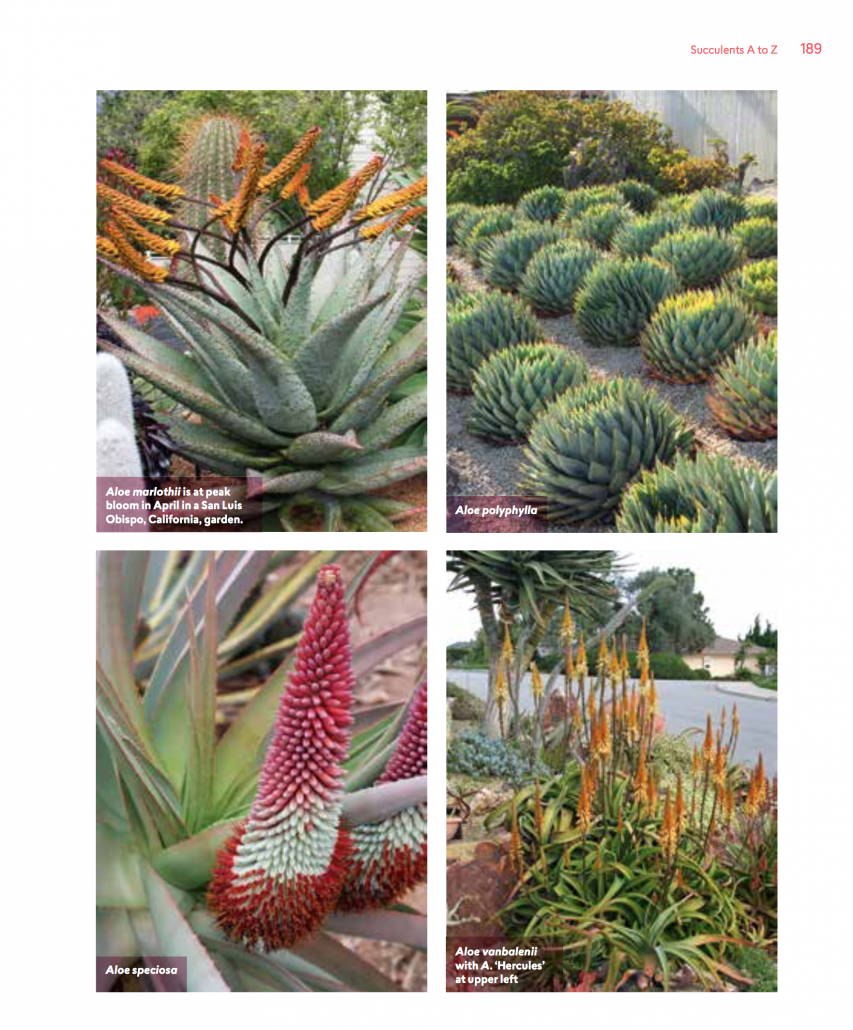
Page 194 — The text says, “When designing with cacti, keep in mind their three main shapes: columnar forms that have “cereus” in their Latin names (ceroids), those with jointed stems such as Opuntia (paddle cacti and cholla), and globular ones such as mammillarias (pincushions and barrels).” First off, although many of the ceroid cacti do indeed have “cereus” as part of their Latin name, others do not (like Carnegiea or Neobuxbaumia or Backebergia or Browningia or Eulychnia), so perhaps you could say “columnar forms that often have “cereus” as part of their Latin names.” And while the three forms you mention are very important categories when thinking of cacti in the landscape, there are also types of cacti that do not fit in any of the three, like epiphytic cacti or scramblers such as Peniocereus. Here is a stab at a re-wording: When designing with cacti, keep in mind the three distinct forms taken by most of the kinds used in landscaping: the columnar ones that often have “cereus” as part of their Latin names; those with jointed stems such as Opuntia (paddle cacti and chollas); and globular types from large to small (barrels to pincushions).
[Item deleted—DLB] Caption of the Bob Barth astrophytum photo: The fuzz on the Astrophytum areoles (not aureoles) is referred to as “wool.” How to phrase the caption? Here’s an attempt: “…but the plants have furry areoles, the points on a cactus from which flowers, spines or offsets emerge.”
Page 195 — Though many ferocacti become cylindrical as they age, others do not (including the F. latispinus illustrated). And although some kinds form clumps, others remain solitary (like F. acanthodes in the Mojave Desert, F. wislizenii in the Sonoran Desert, etc.). Suggested re-wording: “These ribbed and stout-spined cacti from Mexico and the Southwest are spherical when young, but many become cylindrical with age. Some are solitary, while others eventually form clumps.”
Page 197 — For the Opuntia paragraph, you are on firm ground to say it is the most widespread genus of cactus, but “numerous” is a little trickier. There may be more individual plants of Opuntia than any other genus, but in terms of the number of species they are outdone by mammillarias (The New Cactus Lexicon recognizes 163 species of Mammillaria vs. 74 of Opuntia). Of course, the number of Opuntia species is in much dispute, and the same goes for Mammillaria. Perhaps it is best to avoid pinning yourself down on the number of species: “Opuntia or prickly pear is the most wide-ranging genus in the whole cactus family, occurring from Argentina all the way up to Canada.” Nobody could dispute that.
With regard to chollas, though they used to be classified under Opuntia, they have for some time been treated as a separate genus, Cylinropuntia. Suggested fix: “Those on my keep-away-from list include O. microdasys, due to abundant glochids, and also anything in the related genus Cylindropuntia, known as chollas, since these have vicious spines and cylindrical joints that detach all too easily. Chollas were formerly included in Opuntia.”
Page 197 — The problem of what to call the Santa Rita prickly pear is a vexing one. Benson called it O. violacea var. santa-rita; Anderson and Hunt both provisionally accepted it as a species in its own right (Opuntia santa-rita), and Ferguson in his book Prickly Pears classifies it under O. chlorotica, as O. chlorotica var. santa-rita. I think the easiest thing might be to call it Opuntia santa-rita (often sold as O. violacea var. santa-rita).

There is no such species as Opuntia macrocarpus. There has been debate about what species Opuntia ellisiana is a spineless form of, but most people I know have accepted David Furguson’s conclusion that it is Opuntia cacanapa. Furguson uses the designation O. cacanapa ‘Ellisiana’ – and here we go with Latinized cultivar names! In any case, that is the name in usage, so that’s what I would call it.
Page 199 — The cactus in the photo is certainly not Stenocereus thurberi; looks like Stenocereus marginatus.
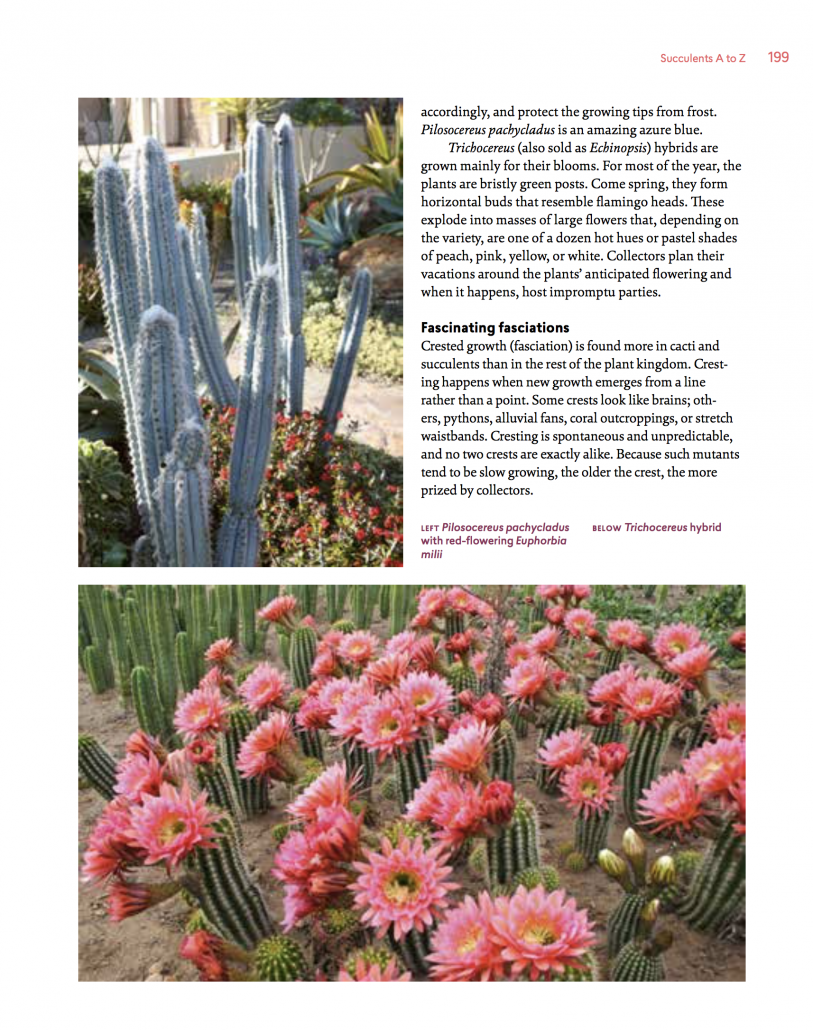 Don’t you think it’s a little harsh to say Trichocereus hybrids when not flowering are “no more interesting than utility boxes”?
Don’t you think it’s a little harsh to say Trichocereus hybrids when not flowering are “no more interesting than utility boxes”?
Page 200 — Do people call the epiphytic cacti “tropical cacti?” I usually hear them called epiphytic cacti or sometimes “jungle cacti,” but am not accustomed to hearing them called tropical cacti. But they are from the tropics…
Page 201 — “Epiphyllum, with long segmented leaves” should be “with long leaf-like segmented stems.” And for “Rhipsalis, which have jointed strands of leaves…” wouldn’t it be better to say, “which have cylindrical or flattened jointed stems”? Just like with opuntia pads, people often mistake flattened cactus stems for leaves, but let’s not encourage this!
The text says, “Grow cotyledons in semishade…” While some species of Cotyledon prefer semishade, haven’t you found that C. orbiculata does well in full sun? It grows fine in full sun in Walnut Creek.
Page 203 — While jadelike crassulas (like C. ovata or C. arborescens) certainly look quite different from stacking ones (like perforata or deceptor or ‘Tom Thumb’), there are plenty of species that don’t fit into either camp (like C. pubescens ssp. radicans or C. multicava, both of which are pictured). Perhaps you could get around this by saying something like, “Crassula is a large and diverse genus containing plants with widely differing forms. Some have definite trunks and look like miniature trees, like the jade tree. Others have stacked leaves which look like they have been threaded along ever-lengthening stems. These two types may seem like they don’t even belong in the same genus, but the key determinant is the flowers, which are tiny, star-shaped, and clustering for both types.” This preserves the contrast you are pointing out, without making it seem like all species of Crassula can be shoe-horned into these two categories.
Crassula ovata — Leaves the size of half-dollars sounds too big; I don’t have one handy to measure, but aren’t they usually more like the size of a quarter? Also, do you think you should put C. argentea in parentheses as a synonym? Plenty of people still call it that.
Page 205 — Crassula perforata — I would say that C. perforata and C. rupestris are both quite common when it comes to stacked-leaf crassulas, and they are very easy to confuse. I think your text is fine as is, but you could include C. rupestris by saying: “Most common of the stacked crassulas are Crassula perforata and Crassula rupestris, two similar species with triangular leaves…” This way the rest of the paragraph can remain unchanged. For the record, though, C. perforata has flowers that tend to be on the cream or yellowish side, while C. rupestris is usually pink or pinkish, which leaves the white-flowered ones in the hard-to-determine category.
Page 206 — Dudleya — The text says D. brittonii rosettes “resemble those of echeverias, but the leaves are flatter and broader, and the tips more pointed.” But there are Echeveria species with leaves flatter and broader than D. brittonii, and plenty with pointed leaves. But it’s hard to know how to concisely state what distinguishes the appearance of dudleyas from echeverias. A greater likelihood of being covered with thick white powder? But then there are dudleyas with none at all. The dead leaves being much more firmly attached to the stems? Maybe so, but you have to wrestle with the plant to find this out. I suppose you could just say something like “their chalky rosettes resemble those of echeverias, and even their flowers look similar, but though the two groups are in the same family, they are not close enough to hybridize.” This mentions the similarity and their degree of relatedness, but without trying to come up with a formula for telling the two apart.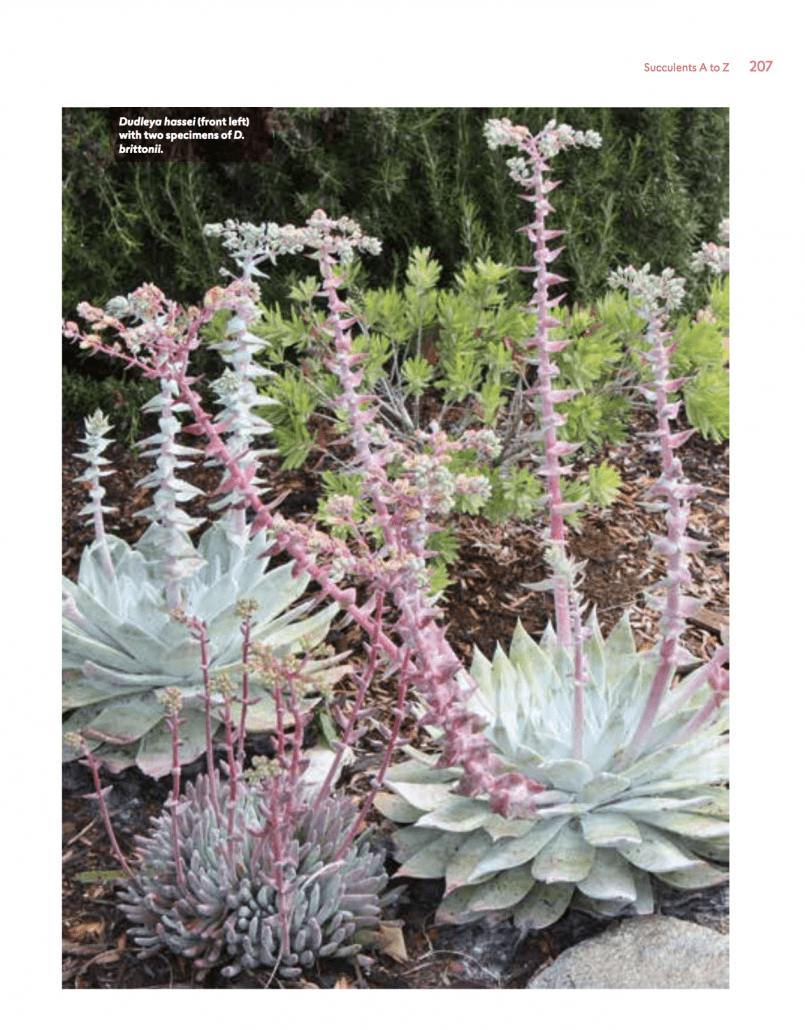 Page 211 – Euphorbia — It says: “Flowers of euphorbias are tiny relative to the plants and come in shades of cream, yellow, and rusty red.” This is not untrue, but it fails to point out that yellow is far and away the most common flower color, and neglects to mention ones that are pure white (esculenta) or green (some medusoids and some forms of horrida) or dark purple (‘Snowflake’). Without going on and on, perhaps you could say “Flowers of euphorbias are tiny relative to the plants and are most often yellow, though some come in other colors like white or purple or rusty red.”
Page 211 – Euphorbia — It says: “Flowers of euphorbias are tiny relative to the plants and come in shades of cream, yellow, and rusty red.” This is not untrue, but it fails to point out that yellow is far and away the most common flower color, and neglects to mention ones that are pure white (esculenta) or green (some medusoids and some forms of horrida) or dark purple (‘Snowflake’). Without going on and on, perhaps you could say “Flowers of euphorbias are tiny relative to the plants and are most often yellow, though some come in other colors like white or purple or rusty red.”
Page 212 — Medusoid euphorbias – “…their prostrate, snakelike leaves resemble locks of hair…” Well, first of all we are talking branches here (or arms, as they are sometimes called), not leaves, and the resemblance is not to locks of hair, but to snakes, which is what Medusa had in place of hair. This is a great photo – almost hypnotic – of the spiral center, so let’s have a caption that doesn’t make me cringe! Perhaps: Medusoid euphorbias, so named because the cylindrical arms that emerge from their central heads are reminiscent of Medusa’s head of snakes, have numerous bumpy green stems that radiate from the core of the plant in a Fibonacci spiral. The tiny yellow, white or red flowers arise at the tips of the arms.” I have avoided saying “in spring,” because we have medusoids in flower all the way through October, though spring is indeed the peak season.
Euphorbia ‘Snowflake’ — There has been much debate about whether ‘Snowflake’ is a form of E. horrida or of E. polygona, but the most knowledgeable people I know (like Gerhard Marx) think that it belongs in horrida; thus Euphorbia horrida ‘Snowflake’. Since many people also have it labeled the other way, you could put E. polygona ‘Snowflake’ in parentheses.
Page 216 — Graptopetalum — Perhaps it is splitting hairs, but describing the color of G. paraguayense, I would add lavender: “plants turn gray-blue when grown in shade and take on tinges of lavender, pink and yellow in full sun.”
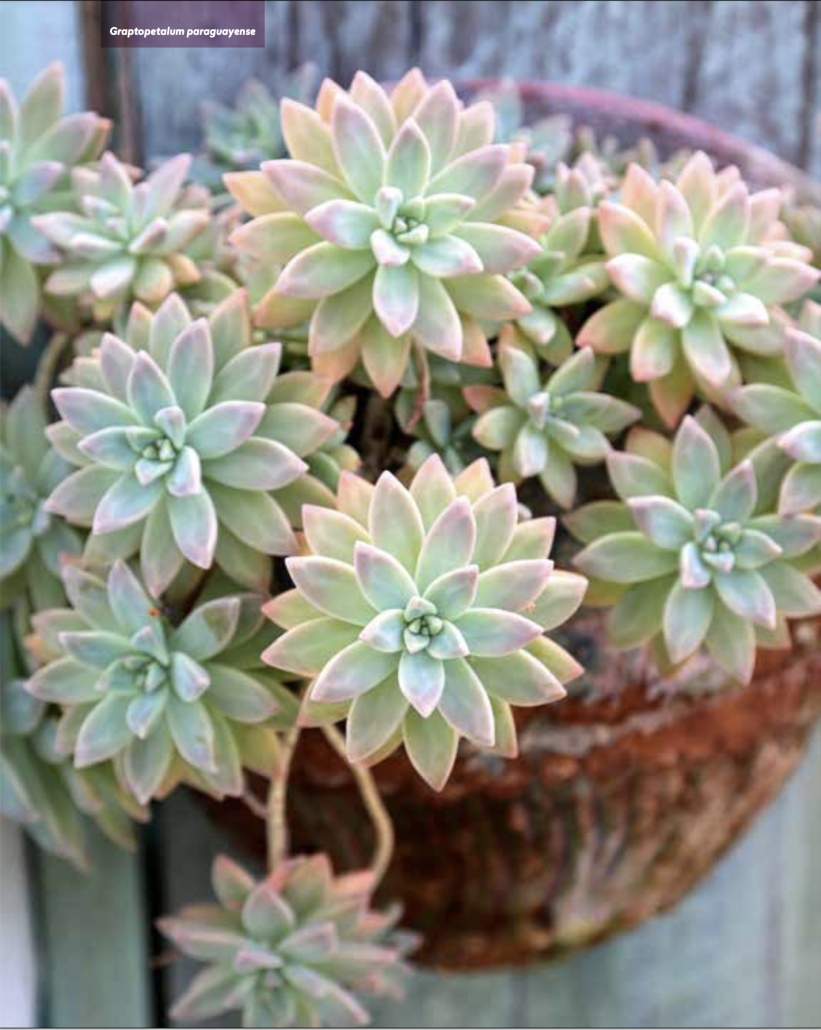
Page 218 — Haworthia — It is not really accurate to say that “the plants are winter growers that go dormant in the hottest summer months.” Some species are from the winter-rainfall zone in the western part of South Africa, but the majority are from either the overlap zone where rain comes in summer as well as winter, or else from summer-rainfall areas. They tend to slow down or stop growing both in the hottest part of the summer and in the coldest part of the winter, so they do a lot of their growing in the spring and the fall (unless you live in San Francisco, where the “hottest part of the summer” is an oxymoron!).
Page 218 — Hesperaloe — You say the common name for Hesperaloe parviflora is red yucca “because of the color of its flowers.” This explains the “red” in the common name, but leaves out the “yucca” part. Possible re-write: “The common name of red yucca is applied to the most popular species, Hesperaloe parviflora, because its reddish flowers are reminiscent of an aloe, while its leaves with curling threads call to mind its relatives the yuccas.” Note that I am trying to sneak in the idea that its resemblance to an aloe is only superficial, while it really is related to yuccas.
Page 219 — Ice plants — Is there to be no mention of the mimicry-type plants in the ice plant family, like Lithops, etc.? Some of them have such evocative names, like “living stones”, “baby toes”, “split rock”, and “tiger jaws”. But perhaps they are a little too much collectors’ plants and not landscape plants.
[Entry deleted — DLB] Aptenia cordifolia — I am accustomed to hearing this plant called candy apple, and I think that name is for the true species, while ‘Red Apple’ is a hybrid with another plant and is a brighter red. (Sunset Garden Book identifies the other parent as Platythyra haeckeliana – but who has ever heard of that?).
Page 220 — Kalanchoe — You are correct that the plants once included in Bryophyllum are now considered a subset of Kalanchoe (by most people; there are still those who prefer to keep them separate). I would vote for doing it just the way you have, with Kalanchoe as the primary name and Bryophyllum as a synonym in parentheses.
Page 231 — As to whether Sedum adolphi and S. nussbaumerianum are the same species or not, there is disagreement. Both come from central Veracruz and are no doubt each other’s closest relatives if indeed they are distinct. Miguel Chazaro, who has done much investigation of the plants in Veracruz, thinks they should be considered synonymous. But the plants we have in cultivation are different, with S. adolphi having shorter leaves which are more closely packed together, and more yellow in color, while the plants of nussbaumerianum have longer and pointier leaves which are a little more spaced out along the stem and turn orange rather than yellow (often with a distinct orange margin). For this reason, I prefer to keep them separate, even if it turns out that the two are merely different forms of one species.
Page 238 – Yucca — It says “Plant yuccas in full sun…” but yuccas are very adaptable and can be grown in partial shade or even quite shady conditions (or as house plants), though they may not flower if given too much shade. Regarding the trimming off of old leaves, there are some whose persistent old leaves give an attractive “grass-skirt” look, and might be considered an asset rather than a liability, like Y. rigida, Y. thompsoniana and Y. rostrata. Note that although Y. rostrata may indeed be single-headed, it often divides and becomes multi-headed (though it does not do so as much as the related Y. thompsoniana). To convey this, you might say “…which over time forms a trunk topped by one or more shimmering pincushions of blue-gray leaves.” (Your imaginitive descriptive phrases like “shimmering pincushion” for Y. rostrata and “whipped cream” for yucca flowers are one of the strengths of the book, since they are both evocative and a little humorous, and relate the plants described to familiar things).
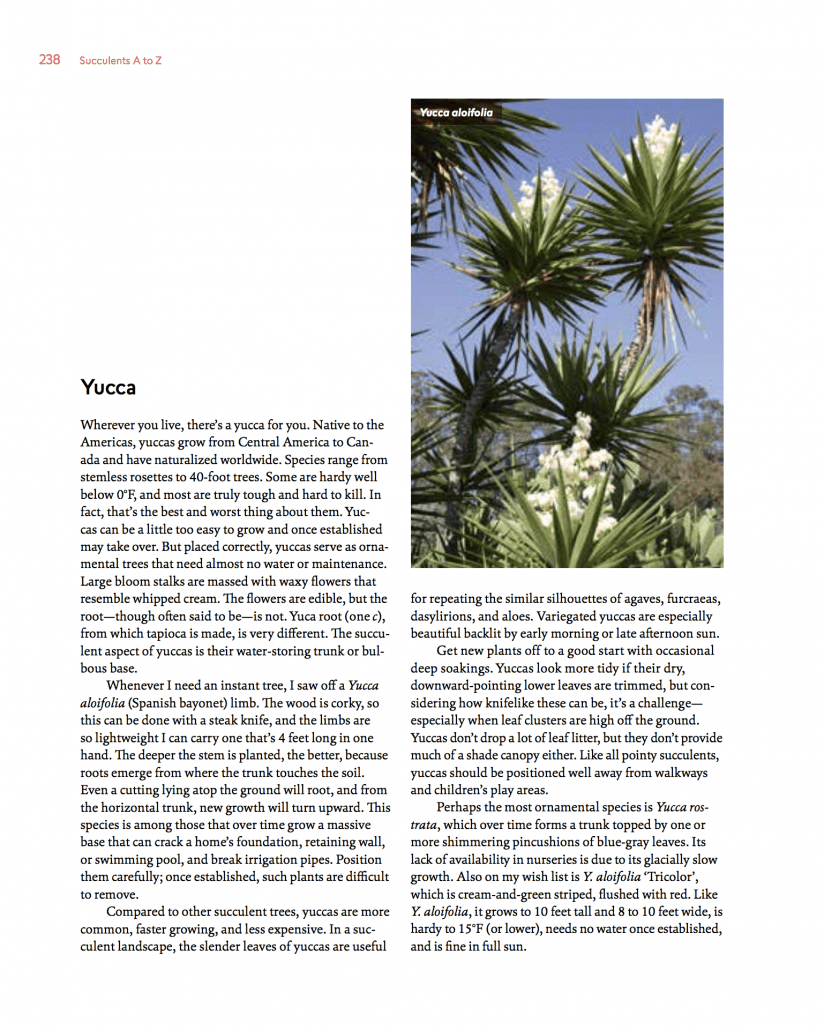 Page 274 — It says, “Daylily hybrids come in a multitude of flower colors, including burgundy, pink, and red.” Of course, this means that it comes in these colors in addition to the usual yellows and oranges, but perhaps it would be better to state this, in case there is someone out there in the world who doesn’t know the usual colors of daylilies.
Page 274 — It says, “Daylily hybrids come in a multitude of flower colors, including burgundy, pink, and red.” Of course, this means that it comes in these colors in addition to the usual yellows and oranges, but perhaps it would be better to state this, in case there is someone out there in the world who doesn’t know the usual colors of daylilies.
Page 283 — In the rosemary entry, you suggest using it with Senecio mandraliscae to repeat the blue color, and then you came up with a great photo which shows exactly this, but oddly the senecio is left out of the caption, as is the agave which dominates the picture.
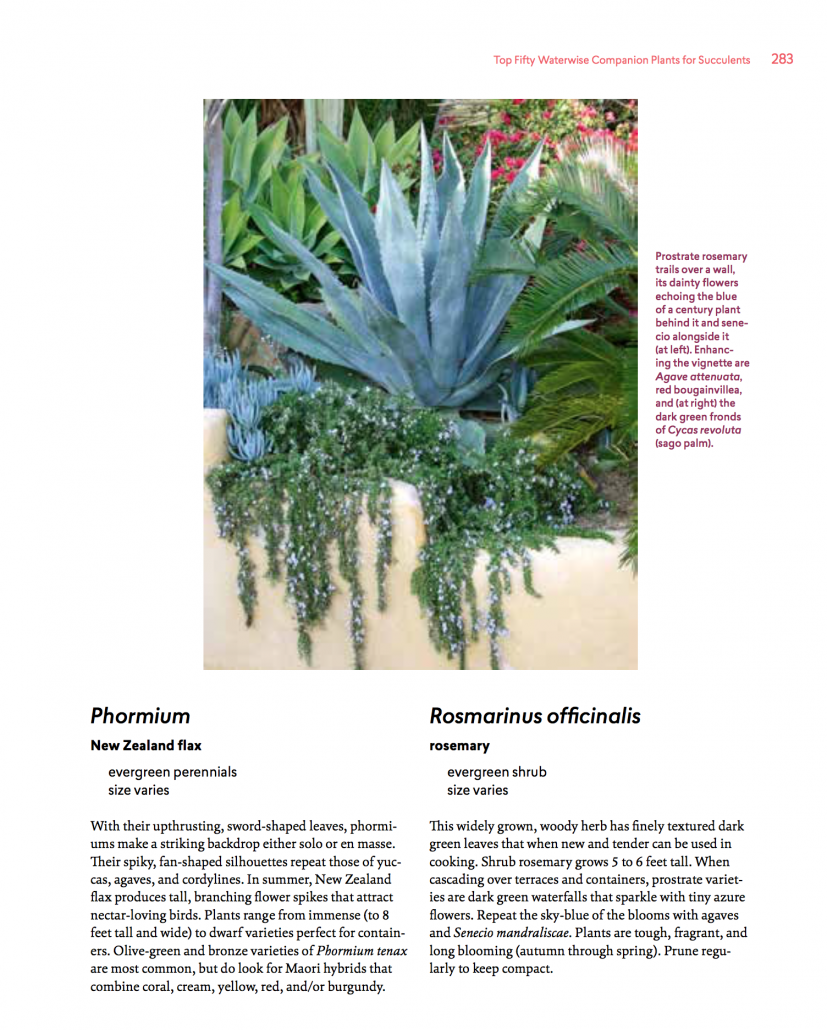
Page 285 — For the entry on Tradescantia pallida, it might be worth mentioning that freezing weather will cause it to die back, but it will bounce back vigorously from the roots as long as the ground doesn’t freeze. Then people who plant it won’t pull it out thinking it had died when the above-ground portion turns to mush in winter (as it does every year at Ruth Bancroft Garden).

